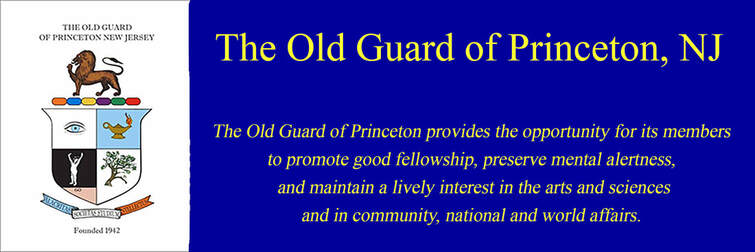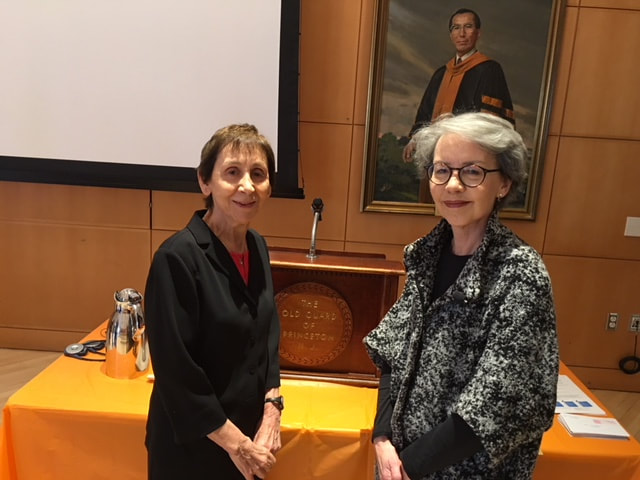November 29, 2017
Climate Change and Architecture:
The Challenges
Esther da Costa Meyer
Professor Emerita, Department of Art and Archaeology,
Princeton University
November 29, 2017
Minutes of the 11th Meeting of the 76th Year
President Jock McFarlane called the meeting to order at 10:15 a.m. The invocation was led by Charles Clark, and the minutes of the Nov. 15, 2017, meeting were read by Claire Jacobus.
Five guests were presented. Stephen Schreiber introduced Joan Girgus; Gregory Dobbs introduced Mary Dobbs; BFG Graham introduced Robert Good; Robert Teweles introduced Peg Bowers; and John Kelsey introduced Gus Escher. The meeting was attended by 118 people.
Marge D’Amico introduced our speaker.
On Nov. 29, 2017, Professor Emerita da Costa Meyer spoke on “Climate Change and Architecture: The Challenges.”
Architecture is one of several disciplines needed to achieve the goal of minimizing the effect of expanding population in limited open space and builders are turning to architects for sustainable designs.
About half of the carbon dioxide emissions in the United States can be attributed to buildings -- these come from the daily use of the buildings and from the energy needed for fabricating and transporting the material to the site. These emissions are contributing to global warming, and the increase of population demands more housing on increasingly limited space. For those reasons, virtually every building now needs to be as energy efficient as practicable. “Green” is a best-seller adjective. Builders like to wrap themselves in sustainability with LEED (Leadership in Energy and Environmental Design) certifications.
Professor da Costa Meyer used 14 examples from around the world to illustrate her points about mitigating the effects of greenhouse gases on the built community. (Her examples came from Hong Kong, Guangdong and Guangzhou, China; Fukuoka, Japan; Mexico City; Chicago, Laguna Beach, Calif.; Sun City, Ariz.; Seattle; Georgia; Madrid; Paris; and Norway and Abu Dhabi.) Those communities that have nowhere to grow outward, like Hong Kong and Mexico City, seem to do best at addressing environmental problems: they grow upward, and they cluster near public transportation.
Roof gardens, or even plants growing up walls, improve the efficiency of buildings and reduce stormwater runoff as well as improve the viewscape from neighboring buildings. Roof plants reduce stormwater runoff and cool the buildings. They also provide local habitat for birds and bees. In Copenhagen, roof gardens are mandatory.
The Persian Gulf states recognize the need to plan for a post-oil culture; they have ample wind and sun to harvest for energy. The poster child for showcasing technology innovation is the city of Masdar, near Abu Dhabi, which was built from scratch to be carbon neutral for 40,000 people and to have all waste recycled. All the technologies on display were imported; “big oil” funded the project. But the city now houses just 300 students. Although the project can be characterized as a failure in regard to its purpose, Masdar is a useful lab for showing which technologies might work and which ones don’t.
In Seattle, an environmentally sustainable building was built for the Bullitt Foundation that was designed to be a prototype model for the Pacific Northwest. All building materials came from within 150 miles, which helped lower the greenhouse gas emissions needed for fabricating and transporting building materials. This passes the locavore test.
The projected lifespan of 250 years for the Bullitt Foundation building raises the question of how long buildings could last; with rapidly changing technologies, new solutions continue to emerge. Does one tear down inefficient buildings when they can’t be retrofitted? Most buildings are built to last 50 to100 years. But what does that really mean? What about heritage buildings, like the Empire State Building?
Professor da Costa Meyer pointed to an imaginative redevelopment of brownfields at an abandoned shipyard in Guangdong, China. Although the overall design is whimsical, it will accommodate sea level rise while preserving the historical memory of the shipyard. Former workers can still recognize the ship ports where they had worked. (Bioremediation was applied to Guangdong, as well. Plants selected for incorporating specific pollutants in their foliage can siphon out toxic material from the soil. The plants are then incinerated, and the process continues until all toxins are removed.)
Generic housing developments in suburbia may be the worst offenders for the local environment. Satellite images of Sun City, Ariz., and a photo of suburban Georgia made her points. Professor da Costa Meyer diplomatically avoided using New Jersey or Princeton University for her examples.
Old Guard questions led to further clarification and explanation of key points of the professor’s presentation.
Respectfully submitted,
Lincoln Hollister
Five guests were presented. Stephen Schreiber introduced Joan Girgus; Gregory Dobbs introduced Mary Dobbs; BFG Graham introduced Robert Good; Robert Teweles introduced Peg Bowers; and John Kelsey introduced Gus Escher. The meeting was attended by 118 people.
Marge D’Amico introduced our speaker.
On Nov. 29, 2017, Professor Emerita da Costa Meyer spoke on “Climate Change and Architecture: The Challenges.”
Architecture is one of several disciplines needed to achieve the goal of minimizing the effect of expanding population in limited open space and builders are turning to architects for sustainable designs.
About half of the carbon dioxide emissions in the United States can be attributed to buildings -- these come from the daily use of the buildings and from the energy needed for fabricating and transporting the material to the site. These emissions are contributing to global warming, and the increase of population demands more housing on increasingly limited space. For those reasons, virtually every building now needs to be as energy efficient as practicable. “Green” is a best-seller adjective. Builders like to wrap themselves in sustainability with LEED (Leadership in Energy and Environmental Design) certifications.
Professor da Costa Meyer used 14 examples from around the world to illustrate her points about mitigating the effects of greenhouse gases on the built community. (Her examples came from Hong Kong, Guangdong and Guangzhou, China; Fukuoka, Japan; Mexico City; Chicago, Laguna Beach, Calif.; Sun City, Ariz.; Seattle; Georgia; Madrid; Paris; and Norway and Abu Dhabi.) Those communities that have nowhere to grow outward, like Hong Kong and Mexico City, seem to do best at addressing environmental problems: they grow upward, and they cluster near public transportation.
Roof gardens, or even plants growing up walls, improve the efficiency of buildings and reduce stormwater runoff as well as improve the viewscape from neighboring buildings. Roof plants reduce stormwater runoff and cool the buildings. They also provide local habitat for birds and bees. In Copenhagen, roof gardens are mandatory.
The Persian Gulf states recognize the need to plan for a post-oil culture; they have ample wind and sun to harvest for energy. The poster child for showcasing technology innovation is the city of Masdar, near Abu Dhabi, which was built from scratch to be carbon neutral for 40,000 people and to have all waste recycled. All the technologies on display were imported; “big oil” funded the project. But the city now houses just 300 students. Although the project can be characterized as a failure in regard to its purpose, Masdar is a useful lab for showing which technologies might work and which ones don’t.
In Seattle, an environmentally sustainable building was built for the Bullitt Foundation that was designed to be a prototype model for the Pacific Northwest. All building materials came from within 150 miles, which helped lower the greenhouse gas emissions needed for fabricating and transporting building materials. This passes the locavore test.
The projected lifespan of 250 years for the Bullitt Foundation building raises the question of how long buildings could last; with rapidly changing technologies, new solutions continue to emerge. Does one tear down inefficient buildings when they can’t be retrofitted? Most buildings are built to last 50 to100 years. But what does that really mean? What about heritage buildings, like the Empire State Building?
Professor da Costa Meyer pointed to an imaginative redevelopment of brownfields at an abandoned shipyard in Guangdong, China. Although the overall design is whimsical, it will accommodate sea level rise while preserving the historical memory of the shipyard. Former workers can still recognize the ship ports where they had worked. (Bioremediation was applied to Guangdong, as well. Plants selected for incorporating specific pollutants in their foliage can siphon out toxic material from the soil. The plants are then incinerated, and the process continues until all toxins are removed.)
Generic housing developments in suburbia may be the worst offenders for the local environment. Satellite images of Sun City, Ariz., and a photo of suburban Georgia made her points. Professor da Costa Meyer diplomatically avoided using New Jersey or Princeton University for her examples.
Old Guard questions led to further clarification and explanation of key points of the professor’s presentation.
Respectfully submitted,
Lincoln Hollister

